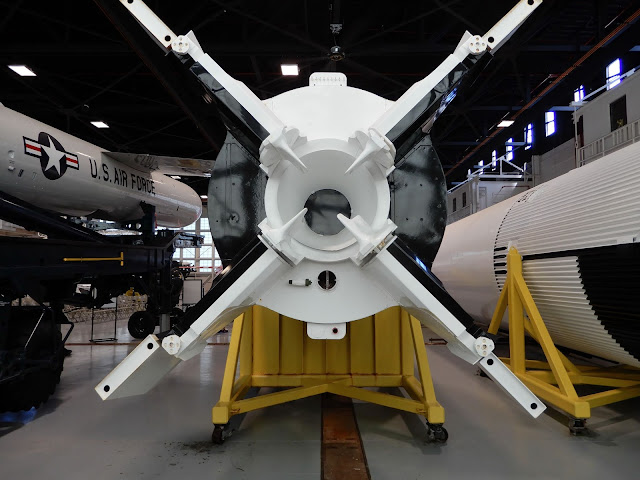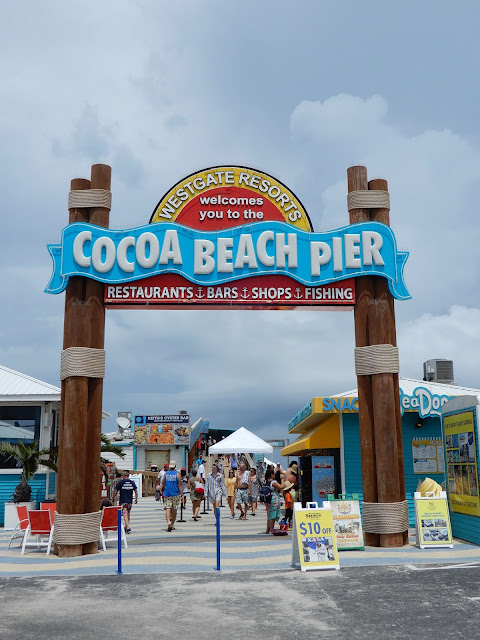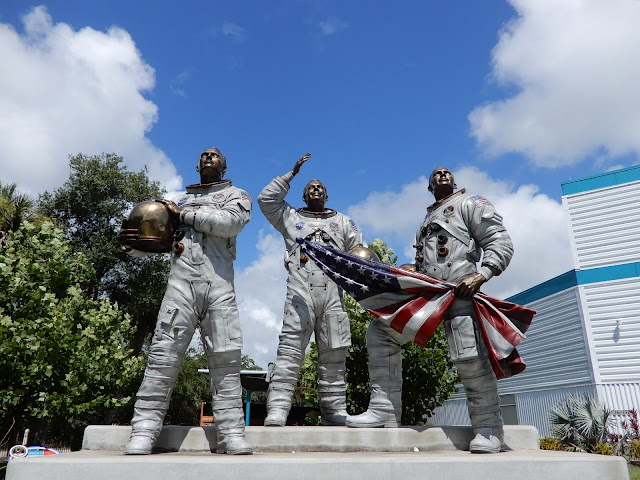We got to Cape Canaveral at around 12:30, too early to check into our hotel so we went to the port for lunch at Grills Tiki Bar. We ate outside and watched dolphins swimming up and down the channel and even spotted a couple of sea turtles. What we didn’t see were cruise ships, which was so strange! After lunch we checked out the Exploration Tower, a welcome center with an observation deck on the seventh floor. Despite the cloudy skies, the views from the observation deck were great. In the distance, we found some of the missing cruise ships – two Disney ships anchored offshore. Hopefully they will be sailing again soon!
 |
| Exploration Tower |
Our hotel was the Hampton Inn at Cocoa Beach. Once we’d checked in and unpacked, we walked to Ron Jon’s Surf Shop to buy Ron a t-shirt since he’s still trying to rebuild his souvenir t-shirt collection. I found a cute hat for myself too and a new turtle sticker for my car. Unfortunately, when we were ready to leave, it started pouring rain. We’d left our umbrellas at the hotel, so we were stuck until the rain slacked off. Since it was drizzling, we didn’t want to go very far for dinner and ended up eating at a restaurant across the street called the Epic Burrito Co, which was kind of a local version of Moe’s. We walked back to the hotel by way of the beach. There were a few families out on the sand, playing and flying kites in the last of the daylight. I’d been planning to watch the hockey game in our room that night, but it wasn’t showing on any of the channels in the hotel’s cable package.
In the morning, we found out that the Lightning had won the game. Woohoo, we were going to the Stanley Cup Finals! Also, it wasn’t raining! I was very happy about that because we had our Lighthouse and Spaceflight Tour at 9 o’clock. We met our tour group in front of the Exploration Tower. There were seven of us in the group plus our tour guide Shelly and our driver Sarah. It was a short ride to the Cape Canaveral Space Force Station (formerly the Cape Canaveral Air Force Station). We’d gotten off to an early start and had a few minutes before we were expected at the lighthouse, so Shelly decided to take us on a quick detour to the beach. The beach was beautiful – untouched except for a fresh pair of sea turtle tracks. I tried to imagine what the area would have looked like if it hadn’t been chosen as a missile launching site back in the 1940’s. It would probably be covered with condos like so much of Florida. Instead, it has miles of undeveloped coastline, a sanctuary for sea turtles and thousands of other species of wildlife.
Next it was on the Cape Canaveral Lighthouse! Because it is located on military property, the lighthouse isn’t accessible to the public except through tours or special events. Ron and I had been able to see it in 2007 but we couldn’t go inside due to lead contamination in the soil around the tower. I’ve always wanted to go back and climb to the top. Since then, whenever we were planning a trip to the area I would check to see if the lighthouse had reopened for climbing, but either there were no tours being offered or the tours were only on weekdays. I was thrilled when I found out that Canaveral Tours now has a tour on Saturdays!
The lighthouse was built in 1868, but it was originally located about a mile closer to the water. To save it from beach erosion, it was moved inland in 1893. Unlike the Cape Hatteras Lighthouse, which was lifted and moved in one piece along steel tracks, Cape Canaveral’s lighthouse had to be taken apart, carted by mule to its new location and then reassembled. Technology changed a lot between 1893 and 1999. :-)
Unfortunately, we still couldn’t climb to the top of the tower for safety/liability reasons, but we did get to go up as far as the 5th floor. We entered the lighthouse through the ground floor doorway, which was added in 1930 when the lighthouse was electrified. To withstand flooding, the original doorway was three levels above the ground with stairs on the outside leading up to it. The lower levels had served as the lighthouse keeper’s living quarters, with bedrooms and a kitchen, until the keepers’ cottages were built.
That morning, a group of Parrot Heads happened to be touring Hanger C next to the lighthouse, so we got to go inside the hanger too, an unexpected bonus. Hanger C is the oldest hanger on the Cape and the building where Dr. Wernher von Braun had his office. Now it is being used to store a large collection of beautifully restored missiles and spacecraft.
 |
| Cape Canaveral Lighthouse |
 |
| stairs to the original entrance |
 |
| replica of the lighthouse keeper's cottage |
 |
| rockets inside Hanger C |
We moved on to the spaceflight portion of the tour. As we drove along the roads of the Cape, Shelly pointed out some of the early missile testing sites. We could see the evolution of the launch complexes over time, with the flame deflectors growing larger and the walls of the blockhouses that protected the ground crew from “anomalies” getting thicker. At Complex 14, where the manned Project Mercury flights were launched, the walls of the blockhouse were 10-feet thick and there were no windows at all, just periscopes sticking up from the domed roof. The blockhouse was surprisingly close to the launch pad and Shelly explained that the distance was limited because all the launch data had to be transmitted over copper cables. As much as I would love to see a rocket launch, I don’t think I want to see one quite that close. :-)
We also stopped at Complex 34, the site of the Apollo 1 fire. Most of the structures had been removed, but the launch platform and two flame deflectors were still standing on the launch pad. Off to one side of the pad, there were three memorial benches engraved with the names of the astronauts who were killed. It was so quiet at the site. All I could hear was the sound of the waves on the nearby beach. Very haunting.
 |
| Mercury 7 memorial at Complex 14 |
 |
| Launch Complex 34 |
 |
| looking up through the launch platform |
 |
| flame deflectors with Launch Complex 37 in the background |
Our last stop was at Complex 26 to visit the Air Force Space and Missile Museum. This is where the first U.S. satellite, the Explorer 1, was launched in 1958. We had time to explore the museum exhibit hall and the firing rooms inside the blockhouse, still furnished with the original 1950’s equipment. Inside the exhibit hall, there was a Gemini capsule that had been used in two unmanned test flights. Shelly told us to picture two men sitting side by side inside that tiny space. I never realized that Frank Borman and Jim Lovell had spent 14 days in one of those capsules during the Gemini 7 mission. 14 days! It took a special kind of person to be an astronaut.
 |
| SpaceX rocket being prepared for a launch |
 |
| new Space Force logo |
 |
| Gemini capsule |
After Sarah and Shelly dropped us back off at the Exploration Tower, we had lunch at Fishlips, then headed down to the Cocoa Beach Pier. Whoa, pier parking was $30! I guess that was reasonable if you planned to spend the whole day at the beach, but we just wanted to have a drink at the tiki bar. We found a parking spot farther down the street and walked. As we sat at the bar, it started to drizzle again, but the rain passed quickly and didn’t seem to bother the beach-goers or surfers. We watched the surfers waiting patiently for just the right wave and a cute group of girls getting surfing lessons.
For dinner that night, we went to Rising Tides, which was right across the road from Grills and Fishlips but had a very different vibe, younger and trendy with lots of colorful artwork. One of the sculptures was made from garbage that had been collected from the Brevard County beaches on a single day. (Pick up your trash, people!) I ordered cauliflower crust pizza and we ate outside on the patio overlooking the Exploration Tower. It would have been a great spot to watch the sunset but unfortunately, it was too cloudy.
Sunday was our day at the Kennedy Space Center. We got to the Visitor Complex just before it opened. The first thing we did after we got through the gates was sign up for bus tickets to the Apollo/Saturn V Center since I’d read that tickets were limited. The 20-minute bus ride to the exhibit took us past the enormous Vehicle Assembly Building, a field of solar panels, an alligator sunning on a bank and a bald eagle’s nest – technology and nature sharing space.
 |
| Kennedy Space Center Visitor Complex |
The Apollo/Saturn V exhibit started with a presentation of the Apollo 8 launch in the Firing Room Theater, which was set up with actual control room consoles used during the Apollo missions. We listened to audio of the countdown as monitors showed footage of the historic launch. It gave me goosebumps. The centerpiece of the exhibit was the massive Saturn V rocket, one of only three remaining in the U.S. There was also a display of astronaut space suits, including Alan Shepard’s suit from his Apollo 14 mission, still covered with moon dust. Seeing the space suits lined up that way reminded me of the suits of armor I’d seen at the Tower of London. Next to a moonscape depicting Aldrin and Armstrong with a Lunar Module was an area where you could walk across a projected image of the moon’s surface and leave footprints. Ok, that was probably meant for kids, but it was fun for me too. :-)
One of my favorite parts of the exhibit was the Moon Tree Garden. The garden’s walkway was in the shape of a figure eight, the trajectory used to get to the moon. There were twelve trees along the walkway, one for each Apollo mission, with a statue of Armstrong, Aldrin and Collins in the center. The trees were descendants of seeds that astronaut Stuart Roosa had taken with him to the moon.
 |
| Apollo 8 reenactment |
 |
| Saturn V rocket |
 |
| Alan Shepard's Apollo 14 space suit |
 |
| "my" footprints on the moon |
We spent a full two hours at the Apollo/Saturn V Center and by the time we got back to the Visitor Complex it was lunch time. We had lunch at the Orbit Café, which was pretty much our only choice since the other food venues were closed due to COVID precautions. I really didn’t see how funneling everyone into one place was supposed to help prevent spreading the virus. Also, we had to order our food using self-serve kiosks and there weren’t any hand sanitizing stations near the kiosks. There was definitely room for improvement in the COVID-prevention measures…
After lunch, we visited the Space Shuttle Atlantis exhibit. This was the exhibit I had been looking forward to most. While I knew about the earlier days of the space program from watching movies like The Right Stuff, Apollo 13 and Hidden Figures, the space shuttle was from my generation. The way people talk about where they were when they heard JFK was shot, I remember where I was when the Challenger exploded and when the Columbia broke apart. I wasn’t born when John Glenn orbited the earth on Friendship 7, but I saw the jet trails from his Discovery launch from the parking lot at work.
The highlight of the exhibit, of course, was Atlantis. After the shuttle program ended in 2011, the remaining shuttles were sent to California, Virginia and Florida for public display. I thought it was fitting that Atlantis, who flew the final mission, had returned home to Cape Canaveral. Seeing the shuttle up close was amazing. We could even see the scorch marks and scratches on the protective tiles from her 33 missions into space.
Another of my favorite parts of the exhibit was the section that showed how the astronauts lived onboard – how they slept, how they ate, how they exercised, even how they went to the bathroom. Velcro was used for everything! :-) There was also a beautiful tribute to the fourteen astronauts who were lost in the Challenger and Columbia disasters. The memorial was a long hallway lined with collections of personal items from each astronaut, chosen by family members to show their individual passions and personalities. At the end of the hallway was a room with a piece of Challenger’s fuselage and the cockpit window frames from Columbia.
 |
| fuselage recovered from Challenger |
There was more than enough at the Kennedy Space Center to fill a whole day, but Ron and I ran out of energy at around 3 o’clock. We drove back to the port thinking we’d go to Grills to cool off with a drink, but it was packed and there was an hour wait for table. Then we walked over to Fishlips, but it was closed. Argh! We ended up back at Rising Tide, which worked out fine because Happy Hour had just started. We sat at the bar and ordered a couple of the $5 appetizers.
Back at the hotel, we took a long walk on the beach before cleaning up for dinner. We ate at the Sunset Waterfront Grill on the West Cocoa Beach Causeway. The food was so-so, but the view made up for it. We watched a pod of dolphins jumping and splashing as the sun went down over the Banana River. Finally, a pretty sunset! We’d been lucky with the weather. It was super humid and a little rainy, but the rain had stayed away for our tours. You can’t ask for more than that in Florida at the end of June.
It was a great trip. It had been a long time since we’d visited the Space Coast except for a few hours before boarding a cruise, so it was nice to get to know the area again. Ron and I both thought the tour with Canaveral Tours was excellent, and of course, I loved seeing the lighthouse. I wished we’d had one more day to spend at the Merritt Island National Wildlife Refuge or the beach, but we’ll have to save that for another trip. And one of these days, we’ll get there for a rocket launch!
























No comments:
Post a Comment